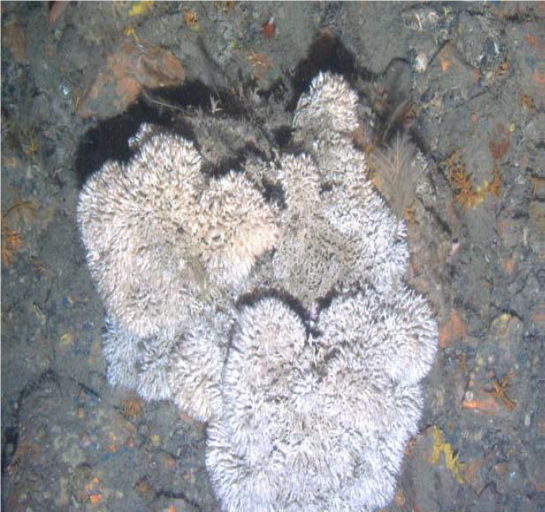Cold-water corals (Figure 1) found in deep waters, such as the Darwin Mounds to the north-east of Rockall and the Mingulay reef complex in the Sea of the Hebrides (both Rockall Offshore Marine Region) may be particularly sensitive to decreases in pH and CO32- (Findlay et al., 2013). These coral colonies serve as shelter, feeding and breeding habitats for fish.
The Mingulay reef complex is subjected to a tidal downwelling caused by internal waves. This downwelling, which brings surface waters down to >100 m, results in a decrease in bottom water nutrient concentrations by ~21% and salinity by ~0.21. Total alkalinity (TA) was found to be uniform through the water column with only a slight change as a consequence of the tidal cycle. The tidal downwelling brought low concentration dissolved inorganic carbon (DIC) surface waters to the reef surface resulting in pH increasing 0.1 pH units. Aragonite saturation showed a similar pattern increasing from < 2.1 to ~2.3 but remaining supersaturated throughout.
The natural variability in pH at the site highlights the importance of understanding the natural processes that marine ecosystems can experience on a local scale. While cold water corals at Mingulay are subject to downwelling events, which may protect skeleton integrity, corals in deeper waters may be exposed to upwelling events bringing high concentration DIC, low pH, low aragonite waters to the reef. Such potential upwelling events may exacerbate impacts under future predicted ocean acidification (OA) scenarios (see Climate change Ocean acidification).

Figure 1: Lophelia pertusa coral from the East Mingulay site in good condition.
Links and resources
|
, 2013. Tidal downwelling and implications for the carbon biogeochemistry of cold-water corals in relation to future ocean acidification and warming. Global Change Biology, 19(9), pp.2708-2719. Available at: https://onlinelibrary.wiley.com/doi/abs/10.1111/gcb.12256. |

